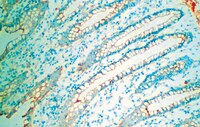Calreticulin has opposing effects on the migration of human trophoblast and myometrial endothelial cells.
K E Crawford,B Kalionis,J L Stevenson,S P Brennecke,N M Gude
Placenta
33
2012
Show Abstract
Calreticulin is a calcium binding, endoplasmic reticulum resident protein best known for its roles in intracellular calcium homeostasis and the quality control processes of the endoplasmic reticulum. There is evidence for a range of activities for calreticulin outside the endoplasmic reticulum, including in the cytosol, on the surface of different cells types and in the extracellular matrix. Recent evidence indicates that human pregnancy is a condition of elevated circulating calreticulin. Calreticulin was increased in the plasma of women throughout pregnancy compared to the non-pregnant state. Calreticulin was also further increased during the hypertensive disorder of human pregnancy, pre-eclampsia. To clarify the roles of circulating calreticulin in pregnancy and pre-eclampsia, the aim of this study was to determine the effects of exogenous calreticulin on two cell types that are relevant to normal human pregnancy and to pre-eclampsia. Human primary myometrial microvascular endothelial cells (UtMVEC-Myo) and the human trophoblast cell line, HTR8/SVneo, were cultured with exogenous calreticulin at concentrations (2 μg/ml and 5 μg/ml) comparable to that measured in maternal blood. The higher concentration of calreticulin significantly increased the migration of the UtMVEC-Myo cells, but significantly reduced the migration of the HTR8/SVneo cells. In the presence of only FGF, FBS and antibiotics calreticulin at 5 μg/ml significantly reduced the number of UtMVEC-Myo cells during in vitro culture for 120 h. These results demonstrate that exogenous calreticulin can alter both HTR8/SVneo and UtMVEC-Myo cell functions in vitro at a (patho-) physiologically relevant concentration. Increased calreticulin may also contribute to altered functions of both cell types during pre-eclampsia. | 22377355
 |
Mutation of Y925F in focal adhesion kinase (FAK) suppresses melanoma cell proliferation and metastasis.
Tomonori Kaneda,Yoshiko Sonoda,Kumi Ando,Takaharu Suzuki,Yasuhiro Sasaki,Tomoyuki Oshio,Megumi Tago,Tadashi Kasahara
Cancer letters
270
2008
Show Abstract
This study focused on the role of focal adhesion kinase (FAK), a cytoplasmic tyrosine kinase important for many cellular processes, in the proliferation, adhesion, and invasion of melanoma cells in vitro and in vivo. We found that the Y925F-mutation of FAK in B16F10 melanoma cells suppressed metastasis in an experimental model, which correlated well with decreased extracellular matrix dependent proliferative capability, adhesive, migrational, and invasive capabilities. Transduction of the mutation Y925F resulted in a down-regulation of the phosphorylation of Erk, the expression of VEGF, and the association of FAK with paxillin. The results provide clear evidence that 925Y of FAK is critical for melanoma metastasis and this phosphorylation site will be an anti-metastatic target. | 18606490
 |











